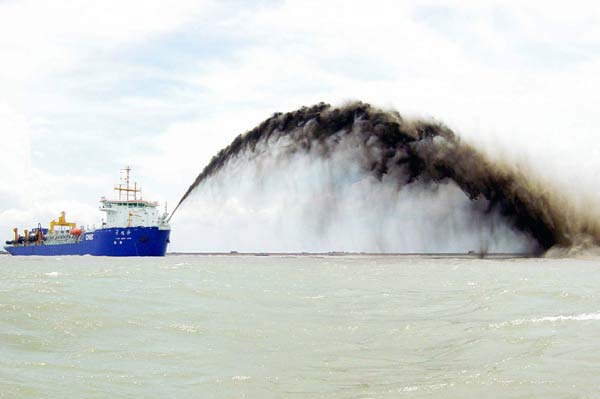Lûleyên kolandinê yên CDSR bi gelemperî ji bo veguhestina qûm, heriyê û materyalên din di projeyên kolandina deryayî de têne bikar anîn, bi keştiyek kolandinê an amûrek ve girêdayî ne da ku sedîmentan bi rêya kişandin an derxistinê veguhezînin cîhek diyarkirî. Lûleyên kolandinê di parastina benderan, avakirina endezyariya deryayî, kolandina çeman û warên din de rolek girîng dilîzin, piştgiriyek xurt ji bo parastina rêyên avê yên nerm û parastina jîngehê ya avê peyda dikin.
Hesabkirina Frekansê
Çerxa kolandinê: Çerxa kolandinê behsa navbera demê dike ku ji bo pêkanîna operasyoneke kolandinê pêwîst e. Li gorî taybetmendiyên bender an rêya avê û guhertinên di kûrahiya avê de, bi gelemperî çerxek kolandinê ya têkildar dê were formulekirin.
Analîzkirina daneyan: Li gorî tomarên dîrokî yên kolandinên avê, daneyên hîdrolojîk, tevgera sedîmentan û daneyên din, meyl û rêjeyên sedîmentasyonê li benderan an rêyên avê analîz bikin.
Rêbaza kolandinê: Li gorî taybetmendiyên materyalê û kapasîteyên teknîkî yên alavên kolandinê, rêbaz û pêvajoya kolandina guncan hilbijêrin da ku qebareya projeyê û bandora xebitandinê diyar bikin.
Encama hesabkirina frekansa kolandinê nirxek texmînkirî ye, û nirxa taybetî divê li gorî şert û mercên rastîn û hewcedariyên endezyariyê were sererast kirin. Di heman demê de, hesabkirina frekansa kolandinê jî divê bi berdewamî were şopandin û nûvekirin da ku şert û mercên navîgasyonê yên benderê an rêya avê li gorî hewcedariyan bin.

Frekansa pêşniyarkirî ya kolandinê
Kanalên kûrahiya kêm kûr (kêmtir ji 20 lingan) dikarin her du-sê salan carekê ji bo lênêrînê werin paqijkirin.
Kanalên kûr ên kişandinê (ne kêmtir ji 20 lingan) dikarin her pênc heta heft salan carekê ji bo lênêrînê werin kolandin.
Faktorên ku bandorê li ser frekansa kolandinê dikin
Jîngeha erdnîgarî:Pêlên erdê binê deryayê û guhertinên di kûrahiya avê de dê bibin sedema kombûna sedîmentan, ku dibe sedema çêbûna gil, qûm û hwd. Bo nimûne, deverên deryayê yên nêzîkî devê çeman ji ber mîqdara mezin a sedîmentan ku ji hêla çeman ve tê veguhastin, meyla wan bi deverên gil heye..Li nêzîkî giravên peravê, di deryayê de bi hêsanî girên qûmê çêdibin. Ev şert û mercên erdnîgarî dê bibin sedema şilbûna rêya avê, û ji bo paqijkirina rêya avê hewceyê kolandineke birêkûpêk a kolandinê dike.
Kûrahiya herî kêm:Kûrahiya herî kêm behsa kûrahiya avê ya herî kêm dike ku divê di kanalek an benderekê de were parastin, ku bi gelemperî ji hêla pêşnûmeya keştî û pêdiviyên ewlehiya navîgasyonê ve tê destnîşankirin. Ger rûniştina binê deryayê bibe sedema ku kûrahiya avê dakeve bin kûrahiya herî kêm, dibe ku xetere û zehmetiyên derbasbûna keştîyan zêde bike. Ji bo ku navîgasyon û ewlehiya kanalê were misoger kirin, pirbûna kolandinan divê têra xwe pir be da ku kûrahiya avê li jor kûrahiya herî kêm were parastin.
Kûrahiya ku dikare were kolandin:Kûrahiya ku dikare were kolandin, kûrahiya herî zêde ya sedîmentê ye ku dikare bi bandor ji hêla alavên kolandinê ve were rakirin. Ev bi şiyanên teknîkî yên alavên kolandinê ve girêdayî ye, wek sînorê kûrahiya kolandina kûrahiya kolandinê. Ger qalindahiya sedîmentê di nav rêjeya kûrahiya kolandinê de be, operasyonên kolandinê dikarin werin kirin da ku kûrahiya avê ya guncaw were sererast kirin.
Çiqas zû sediment herêmê tijî dike:Rêjeya ku sedîment herêmê tijî dike, rêjeya ku sedîment li herêmeke diyarkirî kom dibe ye. Ev bi şêweyên herikîna avê û leza veguhestina sedîmentan ve girêdayî ye. Ger sedîment zû tijî bibe, dibe ku di demek kurttir de kanal an bender nederbasdar bibe. Ji ber vê yekê, ji bo parastina kûrahiya avê ya pêwîst, pêdivî ye ku frekansa kolandinê ya guncaw li gorî rêjeya tijîkirina sedîmentan were destnîşankirin.
Dîrok: 08 Mijdar 2023





 中文
中文